If you’re anything like me, scaling your Facebook ads was on your mind as soon as you got your first conversion.
And if you’re taking baby steps, the first thing most marketers think of when scaling their campaigns is simply increasing their budgets. However, doubling down on the same tactic often leads to a decrease in ROAS and an increase in CPA to match.
If this has ever been you, don’t panic. There’s something you can do about it.
Clients tell us that “our budget is unlimited if we hit our ROAS/CPA goals” all the time. “We want to increase our spend if CPA stays low” is another common comment.
That’s great in theory, but it’s not always as easy as flipping a switch or doubling your budget. Facebook’s algorithm runs the whole show. And if you aren’t careful, your profitability will suffer.
The truth is that increasing your ad spend without taking the right precautions often results in spikes in your CPA as well. As is the case with most things in life: you need to take the bad with the good.
But it’s okay! There’s still plenty you can do to help scale your Facebook campaigns while staying efficient and minimizing fluctuations in your CPA.
With these 9 tactics for scaling Facebook ads, you can start hitting your growth and revenue targets instead of just dreaming about them.
- 1. Increase your budget
- 2. Scale lookalike audiences
- 3. Increase detailed targeting audience list sizes
- 4. Scaling Facebook Ads through ancillary audiences
- 5. Full broad demographic-only targeting
- 6. Build a funnel with TOFU offers
- 7. Dark posting
- 8. Instagram story interactive poll ads
- 9. Power 5
- Final thoughts on scaling Facebook Ads
Get brand new Facebook ad strategies straight to your inbox every week. 23,739 people already are!
1. Increase your budget
This may sound self-explanatory, but in order to scale, you are going to have to spend more money. That’s just the way of the world.
Now, I don’t recommend doubling your budget overnight, but there is an efficient way to continually increase your budget while keeping your CPA down.
Every time you make big changes, such as doubling your campaign’s budget, the Facebook Pixel resets the learning phase. To prevent “shocking the system,” don't increase your budget by more than 10-15% at any given time.
Small changes in the budget are very important. Once your ad sets are out of the learning phase, you want to keep them out as long as you can, because that’s when your campaigns are performing at optimal levels.
2. Scale lookalike audiences
In case you don’t know what a Facebook lookalike audience is, it’s essentially the mirror of an existing custom audience, or an audience you’re already familiar with.
That existing audience might be an uploaded list of your customers, or simply your website visitors, that you want to find more of. Facebook takes that known audience and looks through its existing information to find more people exactly like them.
When creating a lookalike audience, you can create a 1% up to a 10% lookalike. What that means is the percentage of the population you’re targeting that is closest to your custom audience.
So if you create a 1% lookalike of your customers in the US, that new lookalike audience would be the closest 1% match of the US population to your customers.
As you increase the percentage, the audience size grows, but you get further away from an identical match of your custom audience.
Further reading: Facebook Lookalike Audiences: Less Guesswork, More Conversions
The 1% lookalike myth
One of the biggest misconceptions I hear is: “Only use 1% lookalikes because they perform the best. Anything outside of that is too far away from your core audience.”
Although it's true that 1% lookalikes typically have higher conversion rates, we’ve found that larger lookalikes can have lower cost-per-acquisitions (CPAs) and larger conversion volume due to a lower CPMs (cost-per-thousand impressions) and larger audience pool to target.
With a larger audience pool to target, the CPMs are less since you have more ad inventory available. With lower CPMs, you typically see lower cost-per-clicks, therefore helping reduce CPA.
When creating these lookalike audiences, if possible, always try to include lifetime value (LTV) or value-based audiences. Typically, the closer you can get to your perfect customer, the better your lookalike audiences will perform.
Expanding lookalike audiences
At some point after you start scaling Facebook ads, you’ll exhaust your 1-10% lookalike audiences based on existing customers. If you want to continue to scale, try lookalike audiences based on higher-funnel responses.
For example, create lookalikes off of your email list, blog subscribers, add to cart events, or even website visitors. These new lookalikes will create new audiences and help you reach more people.
Just keep in mind that moving up the funnel with lookalike creation takes you further away from your core customer. However, if you have a proper funnel in place, it will still help you scale that much faster (which we’ll talk more about in #9).
3. Increase detailed targeting audience list sizes
A detailed targetingsaved audience (also sometimes referred to as a saved audience or interests audience) is an audience built on Facebook’s targeting, which incorporates demographics, behaviors, and interests to form advertising profiles.
Further reading: (Top Facebook Interest Targeting Tips All Experts Rely On)
After you’ve exhausted your custom and lookalike audiences, detailed targeting audiences can be a great way to reach your target customer.
The one thing to keep in mind here is that, in comparison to custom and lookalike audiences, the intent to convert is lower with a saved audience.
That is because custom audiences know who you are and are more likely to convert. Lookalikes are built off of known audiences and mimic your core audience or customers.
In contrast, detailed targeting audiences are just people who fit a demographic profile, some sort of chosen behavior or interests. They don’t know who you are and don’t perfectly mirror your core customer.
However, detailed targeting audiences are a great way to prospect and reach potential new customers.
To reach people more efficiently while scaling Facebook ads, you'll want to increase the size of your saved audiences so that you have more users to pull from and lower CPMs.
There are two effective ways you can do this:
Increase demographic range
If you are segmenting to specific demographics (example: only targeting ages 24-35, only males, etc), try testing increases the age range or including both male and female.
This gives you more users to target and they still fall into your interest or behavior targeting, so they would still potentially be relevant.
Add audience layers
Let’s say you are opening up a gym in Costa Mesa, CA, and want to advertise a grand opening special.
If you only target the “Physical Fitness” audience, you get 35,000 people to target. But if you add physical exercise, strength training, and personal trainer audiences, you can increase that number to 43,000. That’s a 23% larger potential audience within your target area!
That’s why you should always look to layer relevant audiences onto saved audiences when you're scaling Facebook ads.
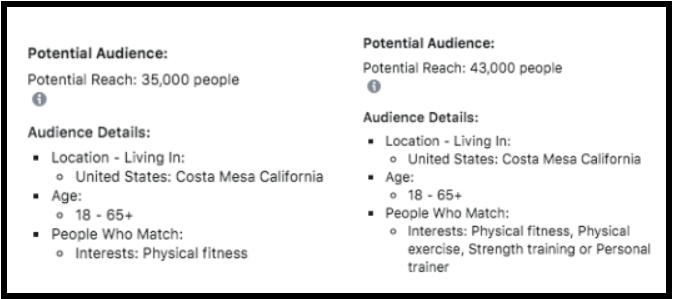
By increasing the list sizes of your detailed targeting audiences, you will have more users to target and lower costs due to the decrease in CPM.
Just make sure the audience layers are relevant to your product and what you are selling.
4. Scaling Facebook Ads through ancillary audiences
In addition to expanding your most relevant saved audiences, the next tactic you can try to help with scaling is called ancillary audiences.
Ancillary audiences are secondary audiences that are outside of your core target market, but who have similar interests or behaviors where they might overlap or be interested in your product or service as well.
Going off of the example from the previous section, you are a gym owner opening up a new gym and want to target people in your area to sign up.
You started off by using this targeting in the previous section:
Males/Females 18-65+ in Costa Mesa who are interested in Physical Fitness, Physical Exercise, Strength training, and personal trainers. This gave you 43,000 people to target.
Let’s say you have been running ads to this audience for a while now, and you want to find more people who might be interested.
Finding your ancillary audience
A good ancillary audience to target might be people who are interested in “healthy diets and healthy/organic food.”
You core market is people who like to exercise, but there's a good chance that people who care about their diet also care about physical fitness. Therefore, this ancillary audience has overlapping interests that can help you expand your reach.
In the screenshot below, you can see how targeting various healthy diet audiences (and excluding your physical fitness interests to reduce overlap) leaves you with 4,100 people in Costa Mesa to target:
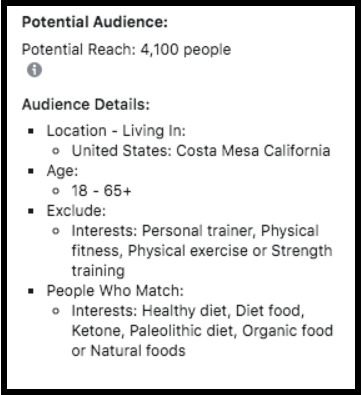
5. Full broad demographic-only targeting
This is NOT for every advertiser. Scaling Facebook ads with this tactic is one of the scariest to use, but it can also be the most rewarding.
This tactic isn’t for everyone is because it works best for advertisers who have a product that literally anyone can use. Generally, this applies more to B2C advertisers than B2B.
What I mean by a product everybody could use, I mean it could be anything from an eCommerce bracelet shop, to a yoga studio, to an online jewelry store.
B2B has a separate set of tactics that work, like these.
So you B2C advertisers out there, especially eCommerce companies looking to scale, this one's for you and could potentially be a game-changer.
Now, each of the example businesses above will have a target audience. For example, the yoga studio might think their core target audience is 24-45-year-old females. The bracelet shop might think their audience is 25-35-year-old males and females. The jewelry store might skew a little young and target 18-30-year-old females.
All that said, literally anyone can wear bracelets, jewelry, and do yoga.
The reason broad targeting is so scary is that you literally remove all the other layers. No Lookalike targeting, interest targeting, or specific demographic targeting. You just target everyone, males and females, ages 18+.
And that’s it.
This tactic is useful for businesses with broad or general products that want to scale because it allows you to cast the widest net to find the most customers.
On top of that, it’s CHEAP. Yes, you heard that right. This tactic is almost always more cost effective, even from a cost-per-acquisition perspective.
The secret of broad targeting: low CPMs
The reason that it is so cheap is because of how cheap the CPMs are.
CPM, which stands for cost-per-1000-impressions, is how Facebook charges you to advertise. So as a general rule, if your audience size is larger, your CPMs are lower. If your audience size is smaller, your CPMs are higher.
The lower your CPMs are, the lower your advertising costs are.
It’s counterintuitive, but with Facebook advertising, the more data-sciencey you get with niche audience targeting, the more you effectively increase your own costs.
However, you still need traffic. Even cheap traffic can have a high enough conversion rate to make sense and keep CPAs low.
That is where Facebook’s machine learning and algorithm take over.
Learning to rely on Facebook's Algorithm
Facebook’s pixel and algorithm have gotten so good that once you have fired a significant amount of conversion events (50 a week to be exact), it will have enough data to predict and find you more people like those past converters.
That means that once you remove all targeting and go full broad, the algorithm will find you more of those people, regardless of age or gender.
The majority of this particular traffic will still be from your core demographic. However, you can generate decent traffic beyond that demographic -- and at a much lower price point than your core audience.
The algorithm basically churns the depths to find you people that you wouldn't have targeted before, all at a low cost because your CPMs are so low.
Now for the fun part: showcasing the data tha proves this works.
The data and proof
Let’s take a small online eCommerce business that deals with a small dollar value but high-margin product. In other words, if they get volume, they make money.
We started off with this client by trying to be audience perfectionists, chasing their core “target audience demographic” with lookalike and saved audiences. Conversions appeared, but it had a consistently negative return on ad spend (ROAS).
We still were making them some money because retargeting was profitable, but we knew we had to improve our prospecting. Otherwise, we would not be long-term partners with this client.
Insert full broad targeting. Not only did this turn profitable immediately, but it became their highest purchase volume and highest ROAS campaign, even higher than remarketing (see screenshot below).
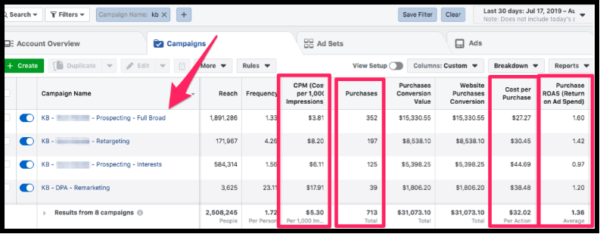
Why (and when) going broad can work
The biggest thing you will notice is just how low the CPMs are for this campaign. Because of the low CPMs and wide audience, we have been able to increase budget over time and turn it into a highly profitable high-volume campaign.
This client had a very small budget to start and was worried that PPC wouldn’t work for them, but they have continued to scale their advertising budget to levels they would never have expected on the back of a full broad FB campaign.
The screenshots below have the ad set level and actual audience targeting of that campaign. As you can see, there is only one ad set highlighted with the targeting and potential reach in the campaign.

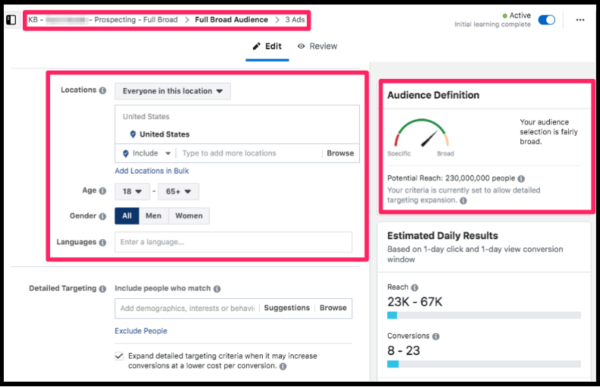
That potential reach of 230,000,000 is why the CPM is so low. And the power of Facebook's algorithm is what makes the campaign work.
Below is another example of full broad. In this case, it didn’t quite have a lower CPA or higher ROAS, but it was very close and was still highly profitable, just by scaling up their Facebook PPC campaigns.
This tactic also added an additional $25k+ of profit that month to their bottom line, but I digress...
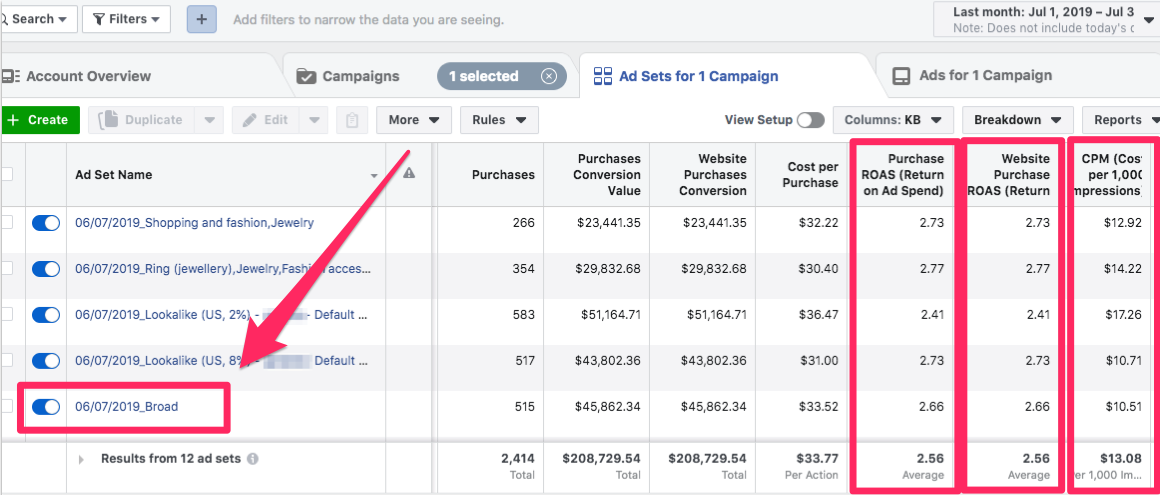
Below is one last example of full broad. This one is not for eCommerce, but still a B2C company, this time for lead gen. Notice full broad has the second-lowest CPA and second-lowest CPM.
It outperformed all saved and lookalike audiences. The only ad set it did not outperform is the Instagram Story-Only ad set, which is its own scaling tactic that we’ll cover in tactic #8. Here's a sneak peek... ?
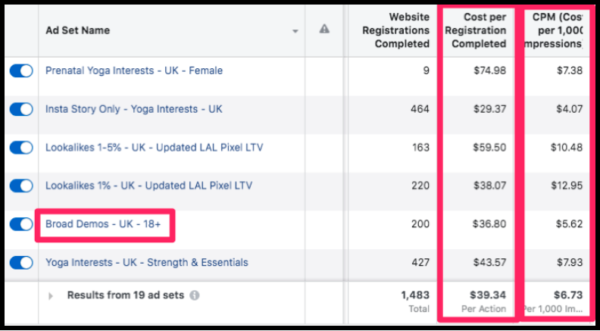
Finally, one more mini case study from an account manager who has seen the power of full broad firsthand:
“Before using the full broad tactic, my client was having trouble getting under a $35 CPA and breaking their ROAS record of about 1.25 at its highest. We targeted interests, lookalikes, and even ran remarking campaigns that received about $30 CPA at their best.
"With full broad, we were able to hit their CPA goal of $26, break their ROAS record with a 1.75, and increase sales by upwards of 15% in the first week of implementation!
"This level of efficiency was even maintained while slowly adding budget to the campaign, starting from a $150 daily budget to it’s now $375 daily budget."
-- Justin Briones, KlientBoost Account Manager
6. Build a funnel with TOFU offers
After the last tactic for B2C businesses, we want to show some love to our B2B advertisers out there.
This tactic is a frequently missed opportunity for lead generation-based B2B companies to help with scaling Facebook ads, as well as PPC campaigns on other channels.
Let’s use a typical B2B SaaS company with a product and a free demo offer as an example.
Say they initially launch on Google Ads with a CTA of “Get Free Demo” and do really well. The search intent behind users looking for a product exactly like what they are offering is strong.
Since paid search is doing well, they want to scale their PPC by adding Facebook Ads. They launch some campaigns with the same offer: “Get Free Demo.”
Before long, they notice that they get far fewer leads that cost more and are less qualified than Google. The initial reaction is to cut their losses and assume that “Facebook doesn’t work for our business.”
But that couldn’t be further from the truth. They just don’t understand the PPC traffic temperatures that drive users on these platforms.
Facebook’s place in your conversion funnel
Facebook is great for initial eCommerce purchase campaigns.
For example, buying socks doesn’t take a lot of education for the consumer. It’s an everyday purchase that everyone needs. So there is no need to create an intricate funnel approach for that type of product.
However, for B2B SaaS, there’s a good chance that most people don’t know who you are or what your product does.
Users on Facebook also aren’t searching for you, so there is no intent. Also, they might not even know that a product like yours exists, or they don't know they have the problem that you're a solution for.
So you can’t expect a cold prospect from Facebook to request a free demo at the same rate you would from a Search ad.
Instead, try a Top-of-Funnel (TOFU) offer like a free guide, ebook, or white paper. If possible, gate it and require an email to download.
This is a far less threatening offer on Facebook than a demo, and it introduces your brand and product in a simple manner. Also, you’re collecting some lead information (email addresses) at a low cost.
Use this TOFU offer for prospecting and then remarket to the downloaders with your core offer of the demo request.
These users are now warmed up, know who you are and what your brand does, and are therefore more likely to convert on your core offer of a demo request.
Finally, as a side benefit, TOFU offers are a nice way of boosting your email/newsletter lists, which will help your email marketing that much more.
7. Dark posting
One of the main reasons Facebook is so successful as a social media platform is the viral potential of its content.
Ad content is no different. Social proof is powerful and can help people make decisions, so this should be used to your advantage.
That’s where Dark Posts come in.
For example, let’s say you have an ad that is relevant to the majority of your campaigns, and you want to roll it out across 10 ad sets.
The old way of doing this would be to recreate the ad 10 different times by clicking on “create ad” in each ad set. But this also creates 10 different, unique post IDs.
And there’s a problem with that.
The problem with unique Facebook Ad post IDs
Creating 10 unique posts based on the same ad spreads the likes, comments, and shares that you accumulate across 10 different places rather than one. This makes it much harder to build up the significant social proof that can take your ad post to another level.
Dark Posting, in contrast, takes the post ID from one ad and boosts that same post ID in other campaigns and ad sets.
This can create a “viral” effect by building all of your social proof on one post rather than 10 different ones.
Building your social proof on one post ID improves the likelihood that more people will click. When potential customers see that others engaged (especially via ‘unbiased’ metrics like “Likes”), they’re more likely to purchase.
For example, an ad post with 7 likes, 2 comments, and 1 share may convince a customer to purchase. But what if that same post could have 100+ likes, 10+ comments, and multiple shares?
The user would think, “Whoa! This company is a big deal,” and be much more likely to engage.
Lastly, this increased engagement can make your post stand out to the FB algorithm, which can reward you with a high relevance score and typically lower CPMs and CPCs.
Find out more about how to leverage dark posting here.
8. Instagram story interactive poll ads
As promised, it’s time to talk about one of Facebook Advertising newest and best-kept secrets: interactive poll ads on Instagram Stories.
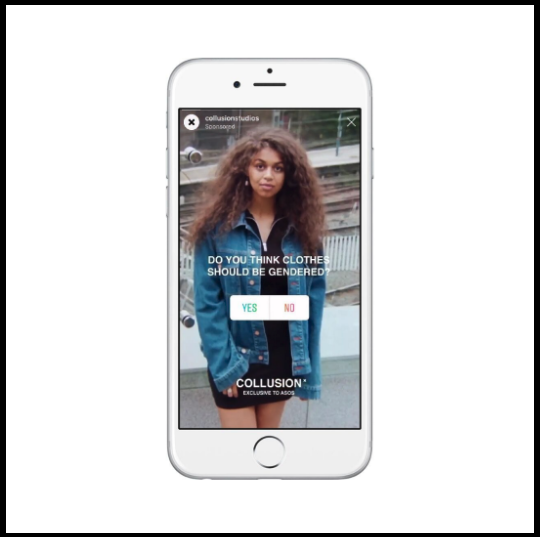
This is a newer ad type is for Instagram Stories specifically.
You only have the ability to have access to this type of ad if, at the ad set level, the ONLY placement you select is Instagram Stories.
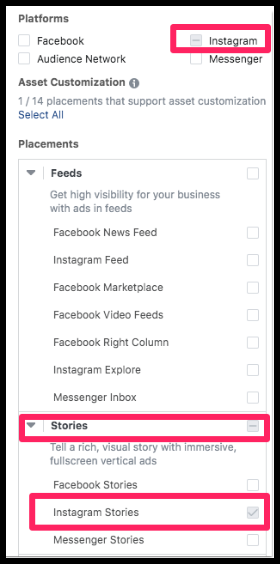
After selecting Instagram Stories as your placement, you can click the “Add an Interactive Poll” box at the ad level.
At this stage, several options pop up for customizing your poll. You can enter questions, answers, and adjust the size of the poll and where it appears on the ad.
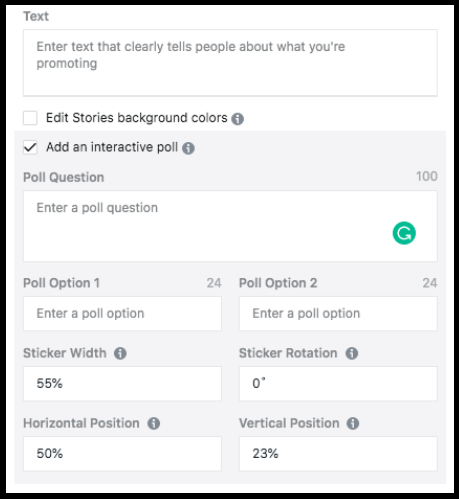
It’s important to note that to create this ad type you’ll need ad creative that is 1080 x 1920 pixels. If you do not have images that fill the stories screen, you won’t be able to create a poll ad.
Why are these polls so good for scaling Facebook Ads?
This new ad type is so effective right now in part because most advertisers aren’t regularly creating content for Instagram Stories.
Because it’s still under the radar, the CPMs are super low.
With CPMs as low as they are with this ad type, this helps translate to low CPAs, even with direct-response lead gen advertisers.
Let’s go back to the yoga studio example from Tactic #5 to see this in action.
In the screenshot below, the “Insta Story Only” ad set sees a CPM of 39% lower than the ad set as a whole. This translated to a 25% lower CPA than the ad set as a whole.
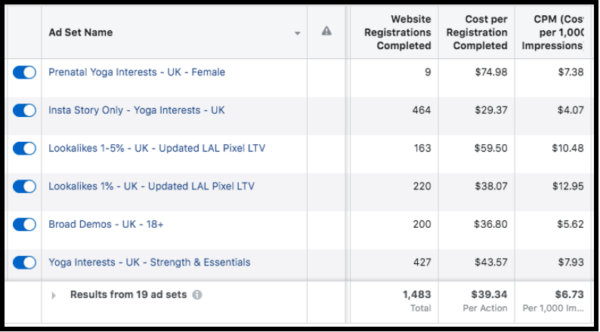
Keep in mind, this is the same offer for Instagram Stories as everywhere else, which is a free trial.
Given the low CPMs and CPAs from these Interactive Poll Ads, this is an easy tactic and low-hanging fruit for some quick wins to help scale your Facebook Ads account.
9. Power 5
Our last tactic for scaling your Facebook Ads in this post is Power 5, Facebook’s internal best practices and laws for Facebook Advertising.
Essentially, if you follow these 5 pillars, your campaign performance will improve.
The five pillars are:
- Simplified Account Structure
- Campaign Budget Optimization
- Automatic Placements
- Dynamic Ads / Dynamic Creative
- Auto Advanced Matching
To make sure you know what each of these 5 pillars means and how to put them in to practice, read up on it here.
Final thoughts on scaling Facebook Ads
Depending on the type of business you’re advertising for, I would test out as many of the tactics above as possible.
The nature of PPC means that you might strike out with one tactic but hit a home run with another. So be sure to test, test, and test some more!
Have you tried any of the tactics above? Are there any you are excited to try?
We would love to hear about any experiences, good or bad, that you’ve had with scaling Facebook ads or any of the above tactics.
Or, if you want us to do the scaling for you, let us know.
